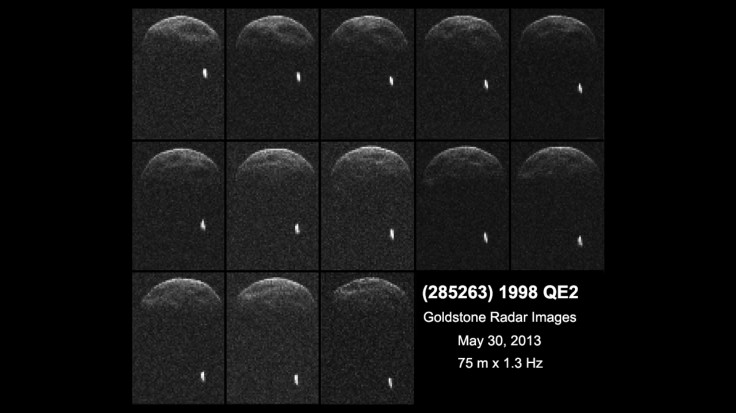Asteroid Swinging Near Earth Friday Has A Moon

The Golden Gate Bridge-size asteroid making a not-so-close encounter with Earth on Friday is bringing a friend along. New NASA radar data shows that 1998 QE2 is actually a binary asteroid, with a tiny moon in orbit around it.
Radar images taken by NASA this week with a 230-foot antenna in Goldstone, Calif., captured some images of 1998 QE2 when it was still 3.75 million miles out from Earth. The asteroid will make its closest approach on Friday just before 5 p.m. Eastern time, when it will come within 3.6 million miles of our planet. The radar imagery reveals the existence of a small satellite circling the 1.7-mile-wide rock. The asteroid’s satellite is estimated to be about 2,000 feet in diameter.
It’s actually not that uncommon to find moons circling asteroids -- we’ve found more than 200 such cases already. One 2,300-foot-wide near-Earth asteroid called (136617) 1994 CC actually has two moons, both thought to be around 164 feet in diameter!
“The very presence of the moon is a good thing,” astronomer Phil Plait wrote for Slate.
Scientists can use the satellite to figure out the mass of the main body of 1998 QE2 by seeing how long it takes the moon to orbit the larger asteroid. The more massive the asteroid is, the faster the moon will go around it at a certain distance. Once we know the mass of the asteroid, we can use that combined with size measurements to figure out 1998 QE2’s density, which will help researchers guess what the asteroid is made of.
Radar imaging of asteroids is based on the simple principle of “pinging” a faraway object with a radio signal, which bounces off of the object and returns to the antenna. The signal that we get back on the ground is not the same as the one we sent out, because it bounces off the parts of the asteroid closest to us first -- that allows us to get a rough idea of how big an object is. Scientists also use radar imaging to get an idea of how an asteroid rotates and use it to improve their calculation of an asteroid’s orbit.
“Of all the data we’re getting on this asteroid pair, the radar is the most precious because of the treasure trove we get from it,” Plait wrote. “Just by bathing it in radio light and watching for the reflection, we get a better orbit for it, we see it’s a binary, and we can determine its mass and even composition ... all from millions of kilometers away.”
The Massachusetts Institute of Technology’s Lincoln Near Earth Asteroid Research program discovered 1998 QE2 in August 1998. This pass will be the closest the asteroid gets for at least another 200 years.
NASA is intensely interested in the prospect of capturing asteroids for study. The space agency’s proposed budget for the 2014 fiscal year includes a plan to robotically grab a small near-Earth asteroid and redirect it to a stable orbit near our planet, thus enabling astronauts to visit and examine it.
© Copyright IBTimes 2025. All rights reserved.





















